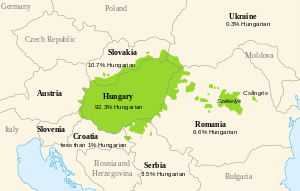Languages of Austria
| Languages of Austria | |
|---|---|
| Official languages | Austrian (Austrian German) |
| Significant unofficial languages |
Alemannic Austro-Bavarian |
| Regional languages | Burgenland Croatian, Slovene, Hungarian, Czech, Slovak, Romani |
| Minority languages | Serbian, Turkish |
| Main foreign languages |
English (73%) French (11%) Italian (9%) |
| Sign languages | Austrian Sign Language |
| Common keyboard layouts | |
| Source | ebs_386_en.pdf (europa.eu) |
The languages of Austria include German, the official language and lingua franca; Austro-Bavarian, the main dialect outside Vorarlberg; Alemannic, the main dialect in Vorarlberg; and several minority languages.
German
German is the national official language and constitutes a lingua franca and de facto second language: most Austrians other than (mostly rural) seniors are able to speak it. It is the language used in media, in schools, and formal announcements. The variety of German used, Austrian German, is partially influenced by Austro-Bavarian and uses many "Germanized" words.
Alemannic
Alemannic is spoken in Vorarlberg. Vorarlberg uses a High Alemannic, the same dialect group as that spoken in Northern Switzerland (outside Basel) and parts of southern Alsace, France. To most Germans and Austrians outside of Vorarlberg it is very difficult to understand, as it is more similar to Swiss German, with many grammatical and pronunciation differences.
Austro-Bavarian
The main native language of Austria outside Vorarlberg is Austro-Bavarian, which is spoken using many different dialects. The northern parts of Austria (including Vienna, the capital) speak Central Austro-Bavarian dialects and the southern parts Southern Austro-Bavarian dialects. Austro-Bavarian differs heavily from high German, making it difficult for German speakers of different regions to understand the native population. Some examples include: The word yes in the German language is spelled ja and pronounced "yah". In Austro-Bavarian dialect yes or "ja" is pronounced "yo" and although Austro-Bavarian is not an official language, "jo" is the spelling of yes. Other words you might only hear while visiting particular regions in Austria and Bavaria that differ from high German include; "Grüß Gott" (may God greet you), Servus (hello), and Pfiadi (goodbye).
Minority languages
A number of minority languages are spoken in Austria, some of which have official status.
Turkish
Turkish is the largest minority language, in a situation mirroring that of Germany, spoken by 2.3% of the population.
Serbian
Serbian is the second largest minority language, with usage by 2.2% of the population.[1]
Burgenland Croatian
Burgenland Croatian, an official language in Burgenland, is spoken by 2.5% of Austrians, and Burgenland Croats are recognized as a minority and have enjoyed special rights following the Austrian State Treaty (Staatsvertrag) of 1955.

Hungarian
While little spoken today, Hungarian has traditionally held an important position in Austria (or, more correctly, Austria-Hungary). Today, Hungarian is spoken by around 1,000 people in Burgenland.
Slovene
Slovene, an official language in Carinthia, is spoken by 0.3% of Austrians. Carinthian Slovenes are recognized as a minority and have enjoyed special rights following the Austrian State Treaty (Staatsvertrag) of 1955.
European Charter for Regional or Minority Languages
Austria ratified the European Charter for Regional or Minority Languages on 28 June 2001 for the following languages in respect of specific Länder:
- Croatian of Burgenland
- Slovene (in Carinthia and Styria)
- Hungarian (in Burgenland and Vienna)
- Czech (in Vienna)
- Slovak (in Vienna)
- Romani (in Burgenland)
References
- ↑ "Archived copy". Archived from the original on January 23, 2010. Retrieved January 23, 2010.
![]() This article incorporates public domain material from the CIA World Factbook document "2006 edition".
This article incorporates public domain material from the CIA World Factbook document "2006 edition".
External links
| Wikimedia Commons has media related to Languages of Austria. |
